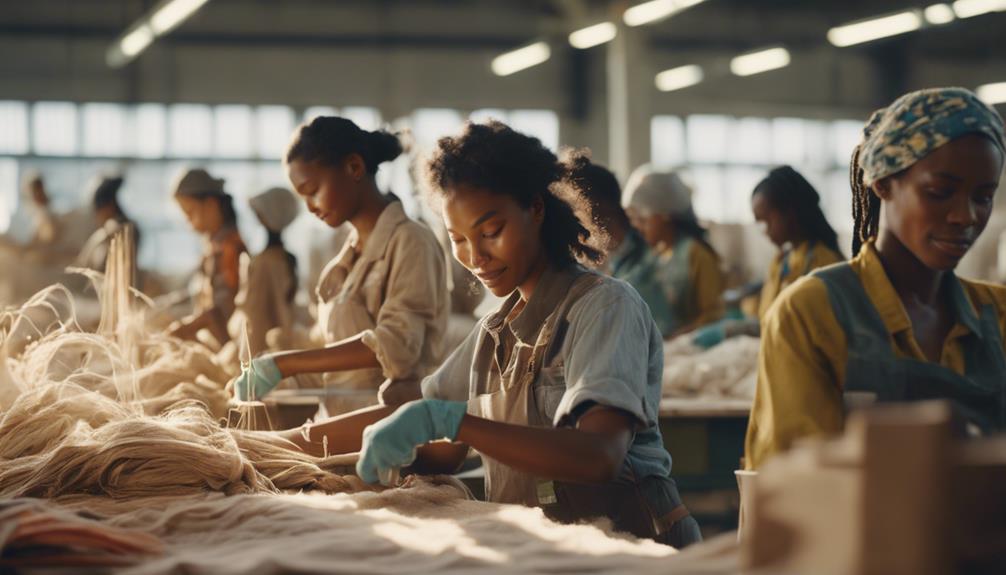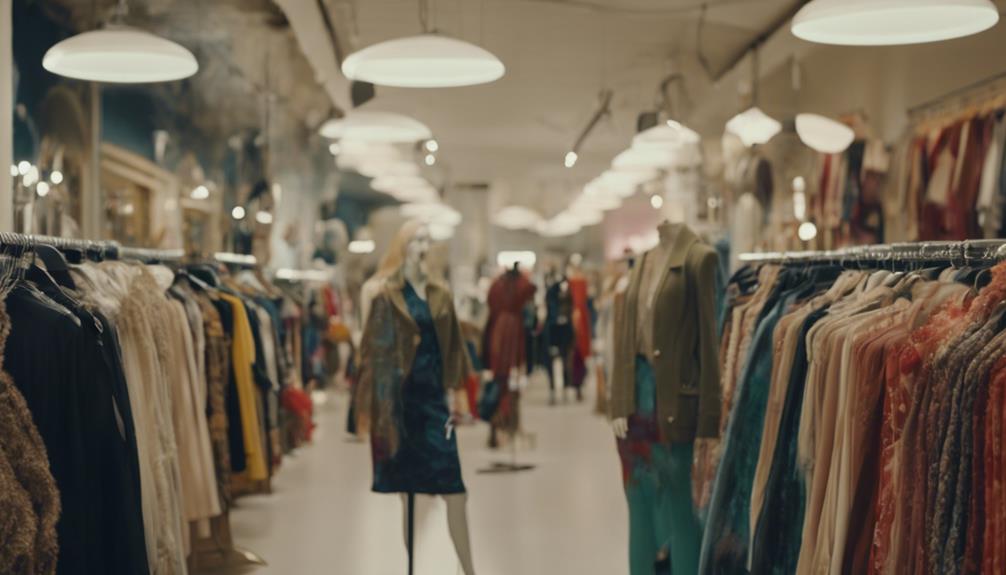Sustainable fashion matters because it directly impacts our planet and people. Did you know that the fashion industry is responsible for 10% of global carbon emissions? This unsustainable cycle leads to environmental degradation and toxic pollution of our waters. Plus, most fast fashion brands exploit workers, with many earning just a few cents for each piece they make. You have the power to drive change by choosing brands that prioritize ethical practices and environmental responsibility. Your choices can influence better practices in the industry. Stick around, and you'll discover more about how you can make a difference! By supporting sustainable fashion trends, you can contribute to a healthier planet and better working conditions for garment workers. Look for brands that use eco-friendly materials, prioritize fair wages and labor standards, and reduce their carbon footprint. By making informed choices and staying updated on sustainable fashion trends, you can be a part of the movement towards a more ethical and environmentally-friendly fashion industry.
Key Takeaways
- Sustainable fashion significantly reduces the fashion industry's 10% contribution to global carbon emissions, aiding in climate change mitigation.
- It minimizes water usage, with traditional t-shirt production consuming about 2,700 liters of water per shirt.
- By prioritizing recycled materials, sustainable fashion can address the current meager 3% usage, promoting a circular economy.
- Ethical labor practices in sustainable fashion improve working conditions and ensure fair wages for garment workers.
The Environmental Cost of Fashion
The fashion industry contributes a staggering 10% of global carbon emissions, making it a major player in climate change. This environmental impact goes far beyond carbon footprints. Did you know that producing just one t-shirt requires around 2,700 liters of water? This excessive water consumption highlights the severe water scarcity issues that conventional garment manufacturing creates.
Moreover, fast fashion is responsible for 20% of industrial water pollution, primarily due to toxic dyes and chemicals released during production. These pollutants not only degrade water quality but also threaten aquatic life and ecosystems.
When you toss out clothes, remember that the average American discards about 81 pounds of clothing each year, leading to around 11 million tons of textiles ending up in landfills annually. The production of synthetic fibers, often used in fast fashion, releases microplastics into oceans, posing significant threats to marine wildlife.
To combat these alarming statistics, choosing sustainable clothing can make a difference. By opting for eco-friendly materials and supporting brands that prioritize ethical practices, you can help reduce the environmental cost of fashion and promote a healthier planet for future generations.
Misleading Sustainability Claims

When shopping for clothes, it's easy to get caught up in brands' claims of sustainability.
But many use greenwashing tactics, masking their lack of transparency with buzzwords that sound good but don't deliver real environmental benefits.
You need to scrutinize those claims to understand the true impact of your fashion choices.
Greenwashing Tactics Exposed
Many fashion brands exploit greenwashing tactics, misleading consumers with claims of 'eco-friendly' and 'sustainable' products while failing to adopt genuine environmentally responsible practices.
This deceptive practice not only confuses you but also perpetuates environmental harm.
When you shop for sustainable fashion, it's essential to recognize these tactics. Here are three common greenwashing strategies to watch out for:
- Vague Terminology: Brands often use terms like 'eco-friendly' or 'green' without concrete evidence or definitions, making it hard for you to decipher their true impact.
- Misleading Product Labels: Some items may be marketed as sustainable while still containing harmful chemicals and non-biodegradable materials, contributing to landfill waste.
- False Commitment: Many companies claim to be committed to sustainability, yet around 97% of their products still rely on virgin resources, indicating a lack of real change.
Lack of Transparency
Misleading sustainability claims plague the fashion industry, making it difficult for you to trust the eco-friendly labels brands flaunt. A shocking 93% of fashion brands fail to provide transparent information about their supply chains or the actual environmental impact of their products. This lack of transparency creates confusion, leaving you vulnerable to greenwashing tactics that many brands exploit.
While brands may tout their commitment to sustainability, only about 3% of fashion items are made from recycled materials. The vast majority still rely on virgin resources, which contradicts their claims of being environmentally friendly. As a consumer, you might believe you're making responsible choices, but the reality is often far from it.
This lack of transparency not only misleads you but also hinders the progress needed to drive meaningful change within the industry. Without clear information, it's tough to hold fashion brands accountable for their practices.
To truly support sustainable fashion, you need to look beyond marketing buzzwords and demand greater transparency from the brands you choose. Only then can you make informed decisions that genuinely contribute to a more sustainable future.
Consumer Accountability and Choice

As a consumer, your choices directly impact the fashion industry and its sustainability efforts.
You can demand brand transparency and prioritize sustainable options, helping hold companies accountable for their practices.
Brand Transparency Importance
Understanding brand transparency is essential for consumers who want to hold companies accountable for ethical practices and make informed choices in sustainable fashion. With the alarming statistic that 93% of brands don't pay garment workers a living wage, it's vital to know who's behind the labels you wear. When you choose brands that value transparency, you support better workers' rights and encourage ethical practices.
Here are three key reasons why brand transparency matters:
- Informed Choices: By knowing a brand's sourcing and labor practices, you can choose companies that align with your values.
- Combating Greenwashing: Transparency helps you see through misleading marketing tactics, allowing you to identify brands genuinely committed to sustainability rather than those using buzzwords.
- Supporting Sustainability Goals: Evaluating brands against the UN's 17 Sustainable Development Goals empowers you to support businesses that contribute positively to the planet and society.
Sustainable Consumption Mindset
In today's fashion landscape, adopting a sustainable consumption mindset empowers you to make choices that reflect your values and reduce environmental harm. The fast fashion industry greatly impacts our planet, contributing 20% of industrial water pollution and 10% of global carbon emissions. By understanding the consequences of your purchasing decisions, you can help mitigate these issues.
It's essential to recognize that only 3% of fashion items are made from recycled materials, while 97% rely on virgin resources. This highlights the importance of consumer accountability in opting for sustainable options. By choosing brands that align with the UN's 17 Sustainable Development Goals, you promote responsible consumption and work to minimize your environmental footprint.
Embracing slow fashion can also shift your mindset. Consider thrift shopping or wearing existing clothing instead of constantly buying new items. This reuse mentality not only reduces waste but fosters a sustainable fashion culture that values quality over quantity.
Holding Brands Accountable
Holding brands accountable is essential for driving meaningful change in the fashion industry and ensuring that your purchasing choices align with ethical and sustainable practices. As consumers, your voice and choices matter. You can push brands to prioritize the welfare of garment workers and reduce the negative impact of fast fashion on our planet.
Here are three ways you can hold brands accountable:
- Research Brands: Before buying, investigate a brand's labor practices and environmental impact. Look for certifications and transparency in their operations.
- Support Ethical Brands: Choose to spend your money on companies that prioritize fair wages for garment workers and sustainable practices. This sends a clear message that you value ethical standards.
- Demand Change: Use your platform to advocate for better practices. Share information about brands that engage in misleading greenwashing or fail to support their workers.
Impact on Labor Rights

Fast fashion's relentless pursuit of low costs severely undermines labor rights, leaving garment workers trapped in a cycle of exploitation and poverty. You might be shocked to learn that about 93% of fast fashion brands fail to pay a living wage, with workers earning a mere 2 to 6 cents per piece produced. This paltry compensation forces many to work excessively long hours—often 60 to 70 hours a week—under strenuous and unsafe conditions.
The lack of basic rights and protections exacerbates the situation, allowing systemic exploitation to thrive within the supply chain. It's disheartening to know that over 170 million children are involved in child labor for garment production, highlighting the severe ethical concerns tied to this industry.
In contrast, ethical fashion brands prioritize fair labor practices, working to improve working conditions and advocate for workers' rights. By choosing sustainable fashion, you support a movement that values dignity, fairness, and transparency.
Ultimately, embracing sustainable fashion isn't just about style; it's a stand for labor rights and an essential step toward a more equitable world.
The Role of Regulatory Measures

Regulatory measures play an essential role in addressing the exploitation within the fashion industry, ensuring that companies are held accountable for their environmental and labor practices. By implementing stricter regulations, governments can considerably reduce the industry's impact on the planet and improve working conditions for garment workers.
Here are three key areas where regulatory measures can make a difference:
- Carbon Emissions: By instituting carbon taxes, fashion companies are incentivized to lower their carbon footprint and adopt sustainable practices, vital for combating climate change.
- Transparency: Enhanced regulations can require brands to provide clear sustainability claims, preventing greenwashing and helping consumers make informed choices about their purchases.
- Resource Conservation: Mandating the use of recycled materials can drastically increase sustainability in fashion, moving beyond the current 3% of items produced with recycled content.
With the fashion industry contributing to 10% of global carbon emissions and 20% of industrial water pollution, it's clear that effective regulatory measures are fundamental for fostering a more sustainable future in fashion.
Embracing these measures benefits not only the environment but also the workers who deserve fair treatment.
Vision for a Sustainable Future

A vision for a sustainable future in fashion embraces responsible production and consumption, aiming to drastically cut the industry's environmental impact. Currently, fashion accounts for 10% of global carbon emissions and 20% of industrial water pollution. By shifting toward sustainable practices, you're not just conserving natural resources—you're also addressing the staggering statistic that only 3% of fashion items are made from recycled materials.
New business models like renting, recycling, and resale are essential to minimizing textile waste, which contributes to 11 million tons of discarded textiles in landfills each year. These models help tackle the root causes of environmental degradation and promote a circular economy. Collaboration among brands and stakeholders is fundamental; look at companies like Patagonia, which donates 1% of sales to environmental efforts, highlighting a commitment to holistic sustainability.
Moreover, educating yourself and others on the environmental impact of clothing production is critical. By embracing a 'reuse' mindset, you can make informed purchasing decisions that drive demand for sustainable practices in the fashion industry. Together, we can forge a path toward a more responsible and eco-friendly fashion future.
Frequently Asked Questions
Why Does Sustainable Fashion Matter?
Sustainable fashion matters because it reduces environmental harm, conserves resources, and promotes ethical labor practices. By supporting sustainable brands, you're helping to decrease waste, lower carbon emissions, and guarantee fair wages for garment workers.
What Is the Problem With Sustainable Fashion?
Amidst the vibrant colors of fast fashion, you'll find a troubling truth; overproduction and greenwashing mask the reality. Most brands mislead you, leaving you unaware of the environmental chaos hidden behind their trendy façades.
Do People Really Care About Sustainable Fashion?
You might care about sustainable fashion, but actions often speak louder than words. Many express interest yet struggle to choose eco-friendly options, balancing affordability and style against their environmental values. It's a complex challenge.
What Are the Negatives of Sustainable Clothing Brands?
Sustainable clothing brands often engage in greenwashing, charge higher prices, and use non-biodegradable materials. This can mislead you about their true environmental impact, limiting accessibility and complicating your choices in ethical fashion.
Conclusion
In a world where the fashion industry accounts for about 10% of global carbon emissions, your choices truly matter.
By opting for sustainable fashion, you're not just dressing stylishly; you're making a statement against environmental degradation and supporting fair labor practices.
With each conscious purchase, you help reshape the industry for the better.
So next time you shop, remember: your wardrobe can be a powerful tool for change, driving the demand for a more sustainable future.









